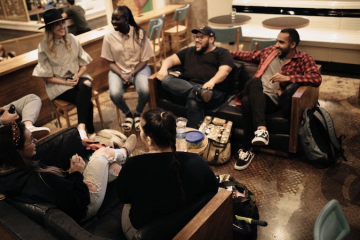How to Use Loops in Your Church

You think our loops are awesome? Excellent – we agree with you! But if you’re like most people, you have no idea how to use them in your worship set yet. Luckily, most churches fall into one of three categories based on how your worship environment is setup. Go ahead and scroll down to the section that best describes your church.
I’ve got a digital mixer and Avioms (or similar system)
You’re in the best possible case. Using loops in your worship set is as easy as it gets. You can play your loops from an iPod/MP3 player, computer, or even burn them to a CD. Have your sound engineer route the outputs of the loop track to two different Aviom channels. These two channels should not be paired so you can have individual control over the click track (usually the left channel) and the loop itself (usually the right channel). Some musicians prefer the click in both ears while others may want it in both. Your sound engineer can then send only the loop track to the main speakers. This approach ensures that your band stays in sync with the track and that they can hear and use the vocal cues in most tracks. If you already use a click track, have the engineer use a mix (sometimes called a bus, or aux) to combine both click tracks to a single Aviom channel.
I’ve got an analog mixer and Avioms
Good news, you can run our loops no problem off an analog mixer! If you are using Avioms and an analog mixer, you probably have an Aviom line level input mixer. The easiest thing to do in this scenario is route the click track (usually the left channel) directly to the Aviom input module. The click isn’t needed in the main PA, so you can save on available channels at the mixer by bypassing it completely. If you have the mic/line mixer from Aviom instead, the same methodology applies, just make sure you use a 1/4 cable to hook up, not a mic cable (XLR). Send the loop track to a channel on the mixer. If it has line level inputs (these are usually 1/4 or RCA jacks and may be labeled as ‘Stereo Inputs’), you can go directly from the MP3 player/CD to the mixer. If it only has mic inputs (XLR connectors), you’ll have to use a direct box. Direct boxes adjust the volume of mp3 players and cd players and makes them suitable for connection to your mixer. Direct boxes are available at most music stores for about $40. Your sound engineer can then mix in the loop track with the rest of the band, just as they would mix in another guitar player or vocalist.
I’ve got an analog or digital mixer, but no Avioms
Really? That’s too bad, Avioms can do amazing things for most churches, but that’s a topic for another day… The good news is that you can still use our loops! The setup is slightly complicated, but not difficult to support or maintain once it is in place. Start by getting the click track to your drummer’s ears. Often the easiest way to have your drummer engage the loop track from your mp3 player at the right time. He gets to wear just 1 headphone – the one playing the click, and keep time with it. The drummer stays on the click track and the rest of the band follows him. If headphones aren’t possible for some reason, you can send both channels from the playback device to your mixer and have your sound engineer mix the click track into the drummer’s wedge, or even better – a mini-mixer that the drummer can use for a headphone mix. There are of course, other setups and more complicated solutions. We want your worship sets to be as good as possible, so if you have questions about a specific implementation or just need clarification, shoot us an e-mail at support@loopcommunity.com and we’ll work with you and your sound team to get you going!




0 Comments